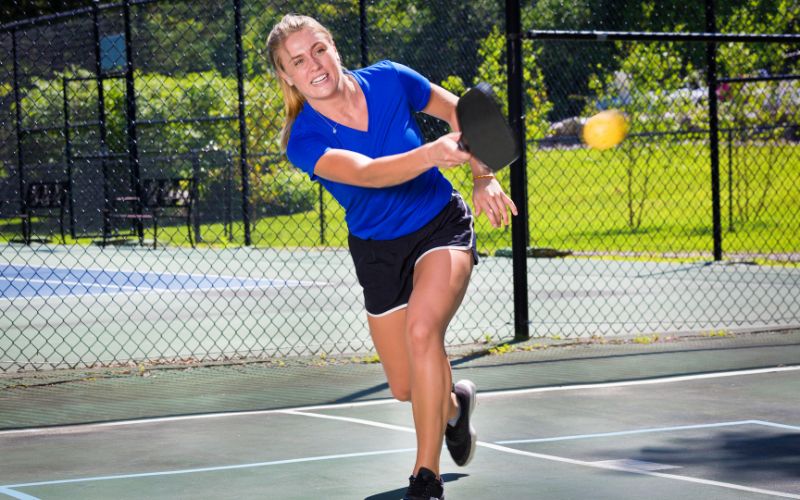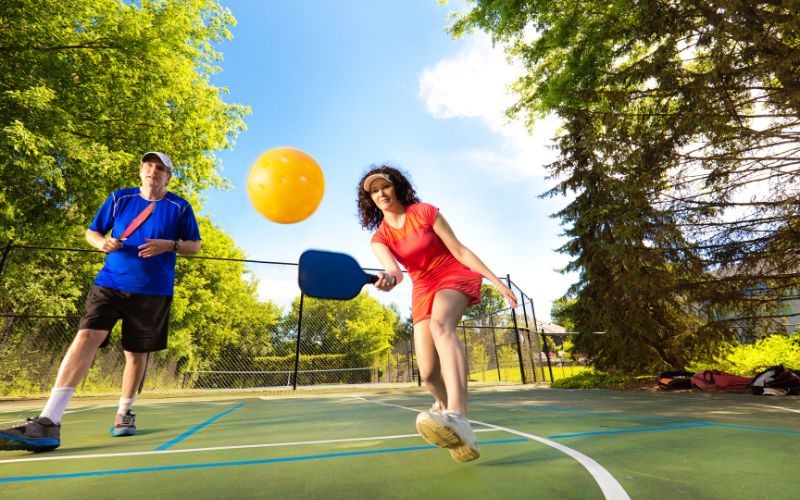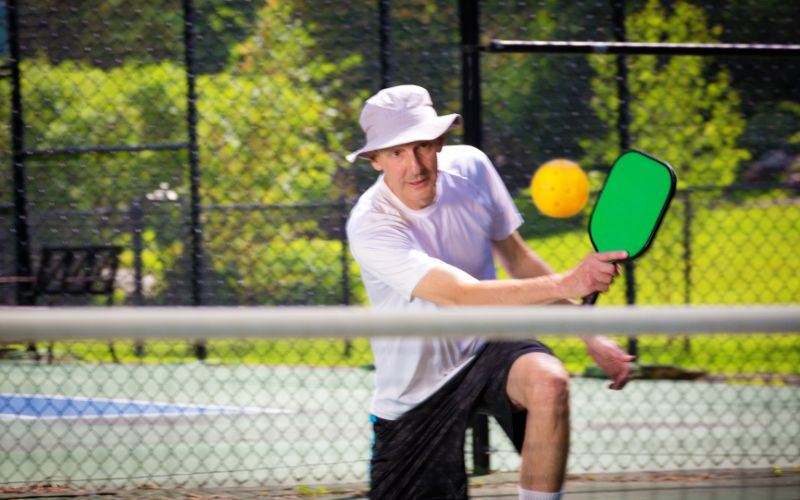Pickleball is a fast-growing sport that combines elements of tennis, badminton, and ping pong. It’s played with a paddle and a plastic ball on a court that’s similar in size to a badminton court. While pickleball is known for its accessibility and fun, it’s important to understand the rules and regulations to play the game correctly. One crucial aspect of pickleball is understanding what constitutes a fault. In this comprehensive guide, on what is a fault in pickleball and cover everything you need to know.
Understanding Faults in Pickleball
In pickleball, a fault is an infraction of the rules that results in the loss of a point or the opportunity to do legal serve. It’s essential to know the common faults, as well as the more specific and nuanced rules that can come into play during a game. Let’s explore these aspects in detail.
Common Faults in Pickleball
- Foot Faults: A common fault in pickleball occurs when a player from the serving team steps at least one foot on or beyond the baseline while serving. Both feet must be behind the baseline when making contact with the ball during a serve. Failure to do so results in a foot fault, and the serve is lost.
- Non-Volley Zone Violations: The non-volley zone, also known as the “kitchen,” is a designated area near the net. Players are not allowed to hit the ball while standing in the kitchen, except when the ball bounces in the zone. Violating this rule leads to a fault.
- Two Bounce Rule: In pickleball, a fault occurs if a player fails to allow the ball to bounce once on each side of the net before attempting to volley it.
- Fault Rules in Tournament Play: Tournament play often has stricter fault rules, and understanding these rules is crucial for competitive players. Faults can be called for various reasons, including foot faults, double bounces, and kitchen violations.
What Causes a Fault in Pickleball
1. Not Allowing Both the Serve and the Return of Serve to Bounce
In pickleball, it’s a fundamental rule that both the serve and the return serve must bounce once on each side of the net before players can engage in volleys. Failing to allow this bounce is considered a fault.
2. Hitting the Pickleball into the Pickleball Net
Hitting the pickleball into the net during a rally is another common fault. The ball must clear the net and land within the boundaries of the opponent’s side to remain in play.
3. Hitting the Pickleball Under the Net or Between the Net and the Net Post
Hitting the pickleball under the net or between the net and the net post is a fault as it goes out of bounds and does not follow the proper trajectory over the net.
4. Hitting the Pickleball Out of Bounds or on Your Respective Side of the Pickleball Net
A fault occurs when the pickleball goes out of bounds or lands on your respective side of the court. Staying within the court boundaries is essential to avoid faults.
5. Allowing the Pickleball to Bounce Twice
In pickleball, players must prevent the ball from bouncing twice on their side. Allowing the pickleball to bounce twice results in a fault.
6. Violating a Pickleball Serve Rule
There are specific rules regarding how to serve in pickleball, including standing behind the baseline and not stepping on or beyond it while serving. Violating these rules constitutes a fault.
7. Contacting the Pickleball Net Posts, Net System, or the Opposing Team’s Side of the Pickleball Court
Any contact with the net posts, net system, or the opposing team’s side of the court during play is considered a fault.
8. Contacting the Pickleball with Anything Other than Your Paddle or Your Hand in Contact with Your Paddle Below Your Wrist
Players must use only their paddle or their hand in contact with the paddle below the wrist to hit the pickleball. Contacting the ball with anything else is a fault.
9. Stopping a Live Pickleball
Once a pickleball is in play, it should not be stopped intentionally by any player. Doing so is considered a fault.
10. The Pickleball Hitting a Permanent Object Before Bouncing
If the pickleball hits a permanent object on the court before bouncing, it results in a fault. The game should continue until the ball bounces.
11. Violating a Non-Volley Zone Rule
The non-volley zone, also known as the “kitchen,” has specific rules. Violating these rules, such as volleying the ball from within the zone without the ball bouncing in it first, leads to a fault.
12. Violating the Commonly Misunderstood “Other” Pickleball Rules
There are several less well-known pickleball rules that players may inadvertently violate. It’s essential to familiarize yourself with these rules to avoid faults.
13. Hitting the Pickleball Before It Passes the Plane of the Pickleball Net
Players cannot hit the pickleball before it passes the plane of the net into their side of the court. Doing so results in a fault.
14. Intentionally Carrying or Catching the Pickleball on Your Paddle
Intentionally carrying or catching the pickleball on your paddle is not allowed in pickleball and is considered a fault.
15. Intentionally Hitting the Pickleball More than Once – Double Hit
Hitting the pickleball more than once consecutively with your paddle is a fault. Players must make a clean hit.
16. Calling an Invalid Hinder (or Let)
Making an invalid hinder or let call can lead to a fault. Players should be familiar with the proper rules and situations for calling hinders or lets.
17. Calling a Time-Out After the Serve
Once the serve is made, calling a time-out is not allowed. Time-outs should be called before the serve for strategic purposes.
Key Concepts in Fault Rules
To gain a deeper understanding of faults in pickleball, let’s explore some key concepts related to this topic.
Service Foot Faults
Service foot faults are among the most common infractions in pickleball. The server must keep both feet behind the baseline when serving. Any violation of this rule results in a fault.
The Non-Volley Zone Line
The non-volley zone line, commonly referred to as the kitchen line, is a critical boundary on the pickleball court. Players cannot enter this zone to make a volley shot unless the ball bounces in it first.
The Pickleball Net
The net in pickleball is similar to that of tennis but stands at a lower height. Hitting the net during a serve or a volley attempt is considered a fault.
Line Calls
Line calls are judgments made during the game to determine whether the ball landed in or out of bounds. Accurate line calls are essential to fair play.
Understanding what constitutes a fault in pickleball is essential for anyone looking to enjoy this rapidly growing sport. Pickleball, with its elements of tennis, badminton, and ping pong, offers a fun and accessible experience, but adherence to the rules is crucial for fair play. This comprehensive guide has covered the various aspects of faults in pickleball, including common faults like foot faults, non-volley zone violations, and two-bounce rules.
Additionally, we delved into specific faults and their explanations, highlighting the importance of allowing both the serve and the return of serve to bounce, avoiding hitting the pickleball into the net, and staying within the court boundaries. These rules help maintain fairness and integrity in the game.
It’s crucial to remember that while pickleball is known for its inclusivity, adherence to these rules ensures an enjoyable and competitive experience for players of all skill levels. Whether you’re playing recreationally or in a tournament, a clear understanding of faults in pickleball will enhance your gameplay and appreciation of this exciting sport. So, grab your paddle, head to the court, and have a fantastic time playing pickleball while staying within the bounds of these essential rules.
Frequently Asked Questions
What is the penalty for committing a fault in pickleball?
The penalty for committing a fault in pickleball can vary depending on the nature of the fault. It can result in the loss of a point, the loss of the serve, or the opportunity for the opposing team to serve.
Can a fault be called by the opposing player or team?
Yes, in most cases, an opposing player or team can call a fault if they believe their opponent committed the fault. However, in tournament play, there may be designated referees to make fault calls.
Are there any specific rules regarding faults in recreational play?
While the basic rules of pickleball apply to recreational play, some groups may have more relaxed interpretations of the rules. It’s essential to clarify the rules with your playing partners before starting a game.






